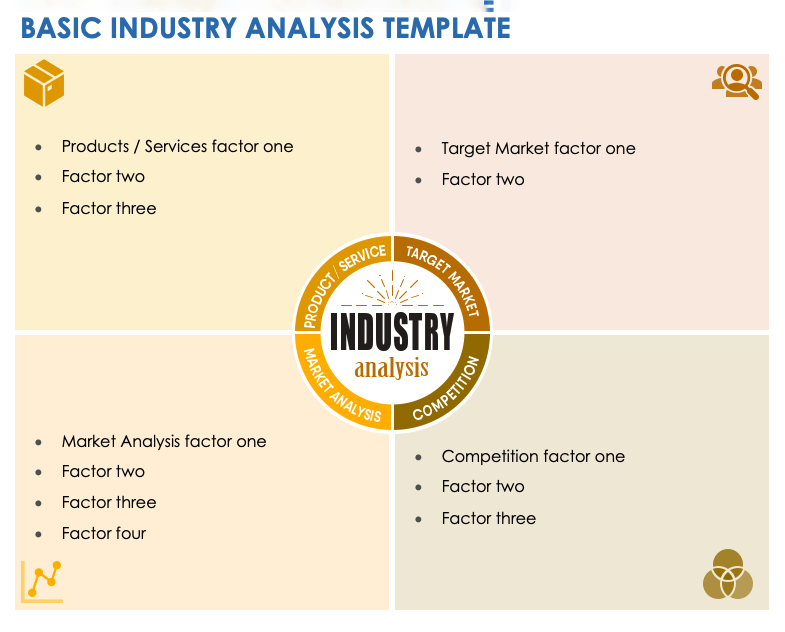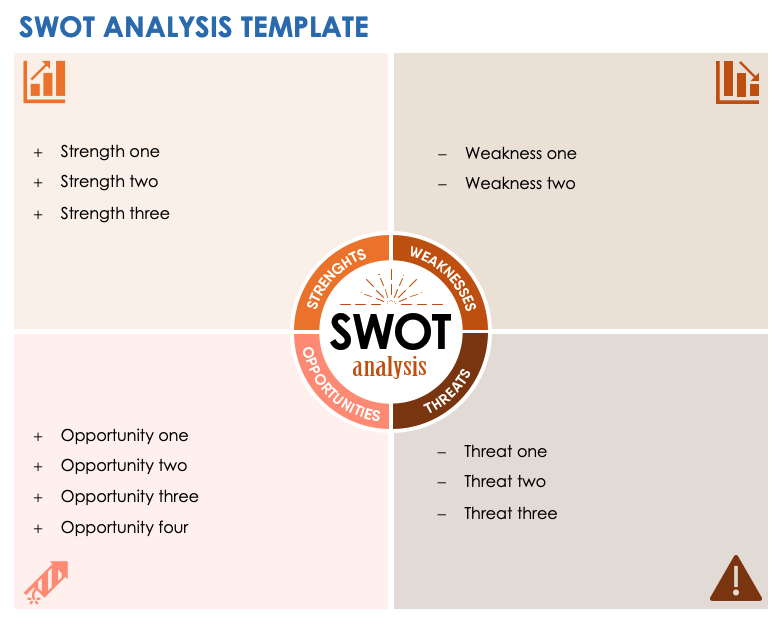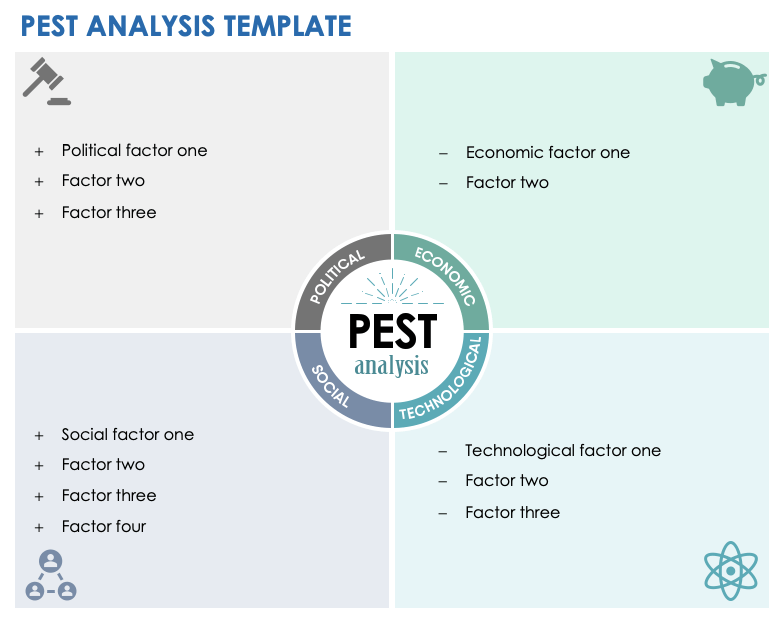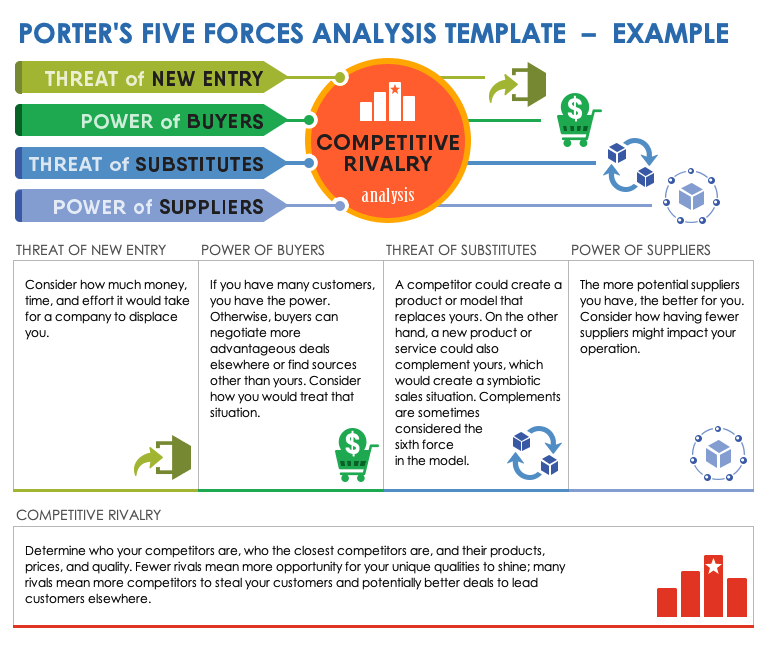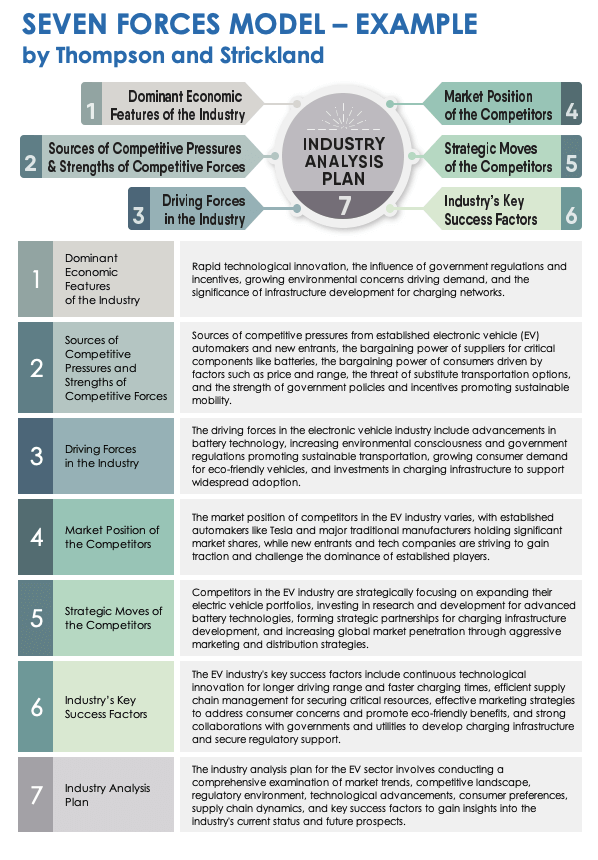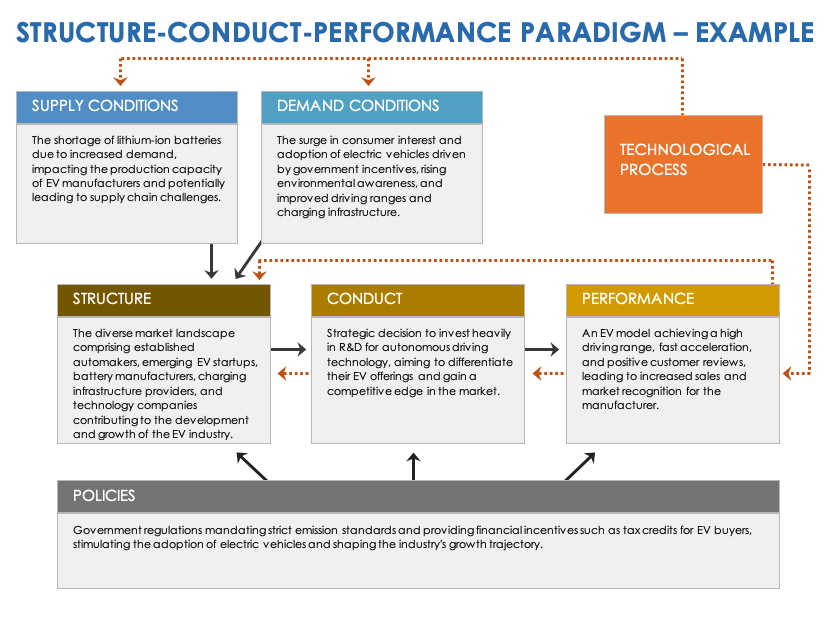Basic Industry Analysis Template
Download a Basic Industry Analysis Template for
Excel | Microsoft Word | PowerPoint | Adobe PDF
Ensure that marketers, analysts, and other stakeholders are aware of your industry-analysis findings with this basic industry analysis template. List each of your competitor’s strengths and weaknesses to help you make informed decisions and develop effective strategies to win key market share in your industry. Use this template to guide business decisions, such as determining which products or services to offer, how to position the company in the market, and which marketing tactics you should employ.
SWOT Analysis Template
Download a SWOT Analysis Template for
Excel | Microsoft Word | PowerPoint | Adobe PDF
SWOT analysis is a valuable tool for any company looking to improve its strategic planning and decision-making capabilities. By completing this SWOT analysis template, you’ll be on the road to increasing your competitiveness with improved research, enhanced decision-making, and effective strategic planning. Use this SWOT analysis template as a strategic planning tool to help your organization identify your internal strengths and weaknesses, as well as external opportunities and threats (SWOT).
For free resources and templates related to SWOT analysis, check out our strategic marketing planning guide.
For more SWOT templates and resources, see our collection of free SWOT templates.
PEST Analysis Template
Download a PEST Analysis Template for
Excel | Microsoft Word | PowerPoint | Adobe PDF
A political, economic, social, and technological (PEST) analysis is useful for assessing the external environment and identifying potential opportunities and threats. By understanding the impact of PEST factors on your business, you can develop effective strategies and mitigate risks. Completing this PEST analysis template will help you assess any external factors that might impact your organization’s effectiveness and advantages compared to the competition.
For more resources and expert tips, see this article with free PEST analysis templates.
Porter’s Five Forces Analysis Template
Download a Porter’s Five Forces Model Template with Sample Text for
Excel | Microsoft Word | PowerPoint | Adobe PDF
Download a Blank Five Forces Model Template for
Excel | Microsoft Word | PowerPoint | Adobe PDF
Use this Porter's five forces analysis template for evaluating the competitive forces at work within your industry, including the threat of new entrants, the bargaining power of suppliers and buyers, the threat of substitutes, and competitive rivalry. For help in completing the template, download the template with sample text. Strategic managers use this analysis to understand the competitive dynamics of any given industry, including the following five forces:
- Threat of New Entrants: Assess the ease of entry for new competitors in the market.
- Bargaining Power of Suppliers: Evaluate the power of suppliers to dictate the terms of the supply relationship.
- Bargaining Power of Buyers: Determine the power of buyers to dictate the terms of the sales relationship.
- Threat of Substitute Products or Services: Analyze the likelihood that customers will switch to a substitute product or service.
- Rivalry: Estimate the effectiveness and intensity of your competition.
By using the Porter's five forces analysis template, you can effectively assess these key five forces, identify the key drivers of competition in your industry, and develop strategies to improve your position in the market.
Seven Forces Model by Thompson and Strickland Template
Download a Strickland Seven Force Model Template with Sample Text for
Excel | Microsoft Word | PowerPoint | Adobe PDF
Download a Blank Strickland Seven Force Model Template for
Excel | Microsoft Word | PowerPoint | Adobe PDF
Proactively assess areas for improvement in your organization with this comprehensive Strickland seven force model template, also known as the Seven-S Framework. The template with sample copy can serve as a guide while you use this strategic planning tool to help you assess these seven key forces for developing strategies to enhance your organization’s overall effectiveness. This Strickland seven force model template is key to effectively evaluating your internal environment and ensuring that you have a strong foundation for success.
Use one of our free competitor analysis templates to proactively focus your analysis on your competitor’s offerings, strengths, and weaknesses.
Structure-Conduct-Performance Paradigm Template
Download a Structure-Conduct-Performance Paradigm Template with Sample Text for
Excel | Microsoft Word | PowerPoint | Adobe PDF
Download a Blank Structure-Conduct-Performance Paradigm Template for
Excel | Microsoft Word | PowerPoint | Adobe PDF
A structure-conduct-performance (SCP) paradigm analysis can help explain the relationship between the structure of your particular industry, the conduct of your organization, and its performance. Use this SCP paradigm template with sample text to guide you through the process.
Evaluate the following categories in the SPC paradigm:
- Structure: Includes factors such as the number of firms, barriers to entry, and degree of product differentiation to see how it affects the conduct of firms operating in that market.
- Conduct: Refers to the actions and strategies of individual firms, such as pricing, advertising, and innovation, which are influenced by the industry structure.
- Performance: Looks at the economic outcomes of the industry, such as profits, market share, and innovation.
By using this SPC paradigm template, you can gain valuable insight into your organization’s market structure and conduct in an industry, which ultimately leads to performance improvements.
What Are the Different Types of Industry Analysis?
Several types of industry analysis are available for companies that want to identify areas for improvement and develop strategies to enhance their competitive position. The types of analysis include SWOT, PEST, Porter’s Five Forces, Seven Forces Model, and SCP Paradigm.
Here’s a brief explanation of some of the most common types of industry analysis:
- SWOT Analysis: This analysis evaluates the strengths, weaknesses, opportunities, and threats (SWOT) of a particular industry. Businesses use SWOT analysis to identify their internal strengths and weaknesses, as well as external opportunities and threats that could impact success.
- PEST Analysis: This analysis evaluates the political, economic, social, and technological (PEST) factors that could impact an industry. PEST analysis helps businesses understand the external factors that could impact their industry and develop strategies to mitigate risks and capitalize on opportunities.
- Porter's Five Forces Analysis: This type of analysis focuses on the competitive forces within an industry, including the threat of new entrants, bargaining power of suppliers, bargaining power of buyers, threat of substitute products or services, and intensity of competitive rivalry.
- Seven Forces Model by Thompson and Strickland: The seven forces model is a strategic analysis framework that expands on Porter's five forces model by considering two additional forces. By analyzing these seven forces, businesses can develop strategies to leverage their strengths and address the challenges presented by each force.
- The Structure-Conduct-Performance (SCP) Paradigm: This model helps explain the relationship between the structure of an industry, the conduct of its firms, and their performance.
Overall, each type of industry analysis serves a unique purpose and can provide businesses with valuable insights into their industry and competitive landscape.
How Do You Conduct an Industry Analysis?
Companies can conduct an industry analysis effectively by gathering data and identifying key opportunities and threats in the market. They use that information to develop effective strategies to succeed.
Conducting an industry analysis effectively typically involves the following seven steps:
- Define the Industry
Define the industry you want to analyze. You should identify the scope of the industry, including the products or services offered, customer segments, and geographic area in which it operates. - Gather Data
Collect data from various sources, such as industry reports, government statistics, and trade publications. Gather information on market size, growth rates, industry trends, key players, and other relevant factors that impact the industry. - Analyze the Competitive Landscape
Conduct a Porter's five forces analysis to evaluate the intensity of competition within the industry. Identify the key players in the market, their market share, and their competitive advantages and disadvantages. - Assess the Industry's Economic Characteristics
Use a value chain analysis to identify the cost drivers and areas where companies can improve their efficiency. Analyze the profitability of the industry, including the profit margins, return on investment, and other financial metrics. - Conduct a PEST Analysis
Evaluate the external factors that impact the industry, including political, economic, social, and technological factors. List potential opportunities and threats that might arise from changes in the external environment. - Identify Key Success Factors
Identify the factors that are critical to success in the industry, such as innovation, cost management, customer service, or distribution capabilities. - Make Strategic Recommendations
Based on the findings of your analysis, make recommendations for how the company can improve its performance. This might include developing new products, increasing operational efficiency, or pursuing new markets.
Conducting an industry analysis requires a thorough understanding of the industry and the key factors that impact its performance. By gathering and analyzing this data, businesses can make informed decisions about their strategic direction and resource allocation.
To learn more about analyzing your competitors, see our guide to competitive analysis.
Why Industry Analysis Is Important
Industry analysis is important because it provides an essential tool for businesses and organizations to gain critical insights into the competition. Businesses use the findings to make informed decisions and develop effective strategies for growth and success.
Industry analysis also helps you identify key competitors and understand their competitive strengths and weaknesses. This can help your businesses make informed decisions about their strategic direction, resource allocation, and market positioning, ultimately leading to greater success in the market.
What Are the Objectives of Industry Analysis
The objectives of industry analysis are to understand the current and future states of an industry. It also identifies key factors that impact profitability and competitiveness. Industry analysis can help inform decisions about strategic direction, resource allocation, and market positioning.
In short, the primary objective of industry analysis is to provide businesses with a comprehensive understanding of their industry, including its opportunities, challenges, and competitive landscape.
The key objectives to effective industry analysis are the following:
- Identify Market Trends: A critical component of industry analysis, market trends help businesses identify and understand emerging tendencies in their industry. To successfully identify trends, you might conduct market research and look for patterns in the data, including consumer preferences and economic indicators.
- Assess Market Size and Growth Potential: A critical objective of industry analysis is that it helps businesses analyze industry data, so they can determine the size of their potential market and evaluate the opportunities for future growth. Assessing market size and growth potential might involve clearly defining your market, analyzing marketing data, and conducting primary research data directly from customers and industry experts.
- Understand the Competitive Landscape: By analyzing your competitors, you can identify industry trends and understand how your rivals are adapting to these trends. These details can help you develop strategies to compete effectively in the market.
- Identify Opportunities and Threats: By identifying and responding to opportunities and threats, you can develop effective strategies, allocate resources efficiently, and manage risk effectively.
- Determine Industry Profitability: Determining industry profitability helps you understand the economic viability of your industry and the potential returns on investment. Use this information to make informed decisions on where to invest capital, allocate resources efficiently, and develop effective strategies to increase profitability and gain a competitive advantage.
Create and Implement a Plan from Your Industry Analysis Findings with Smartsheet
Empower your people to go above and beyond with a flexible platform designed to match the needs of your team — and adapt as those needs change. The Smartsheet platform makes it easy to plan, capture, manage, and report on work from anywhere, helping your team be more effective and get more done. Report on key metrics and get real-time visibility into work as it happens with roll-up reports, dashboards, and automated workflows built to keep your team connected and informed. When teams have clarity into the work getting done, there’s no telling how much more they can accomplish in the same amount of time. Try Smartsheet for free, today.
